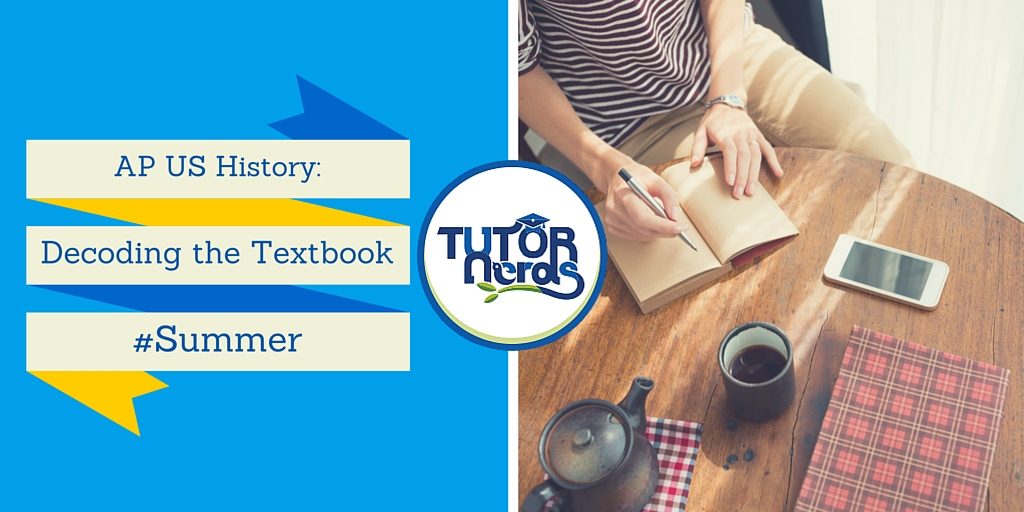AP US History: Decoding the Textbook


Students preparing for their AP US History class in the fall will find a very thick and in-depth textbook at their desk. Although US History only covers events from the period leading up to the Revolutionary War to current, the course is much more intricate than AP World History or AP European History courses. Students will learn about pivotal battles, important dates, and social change throughout the history of the United States. Reading through the text book can seem overwhelming at first, however, if students know how to utilize the study different elements within the book they will have an easier time during the summer and throughout the year. When broken into smaller parts, AP US History can be very manageable, and students will have a better chance at success if they can decode their textbook before the first day of class.
One of the first things students should look at is the glossary at the back of their text book. Students using an online version of their textbook will find it at the bottom of their chapter list. The glossary is a list of all important or unfamiliar terms used throughout the text. If students know how to use the glossary, they will save tons of time because they won’t have to search through endless pages looking for a vocab word from the previous week. Additionally, students should be aware that each and every word found within a glossary has been highlighted as important for a reason. These words often appear on quizzes and exams and are used in class discussion (READ: Last Minute AP Study Guide).
Most US History textbooks have timelines that appear throughout the book. This is an important element of learning and an opportunity for students to learn about cause and effect as well as historical consequences. For instance, perhaps a small conflict leads to a much larger battle or war; maybe changes in politics lead to economic change. It’s essential for students to be able to learn what happened first, second, and third and understand the importance of linear elements in general. Whenever a student comes across a timeline in their book, they should make note of it and record the page so they can refer to it easily in the weeks to come.
Nearly every student will pass over the chapter introduction; however they can be extremely useful. The chapter introduction will let students know what the chapter covers, as well as what it does not, and covers some learning objectives. If students take a couple of minutes to look at their chapter introduction before reading, they’ll know exactly what is going to be introduced, and this will give them a lot of clues about what will be covered in class as well as in at-home assignments. Upon completing the chapter, students are encouraged to look back at the learning objectives and see if they meet some or all of them. If they don’t, they should consult their teacher or a tutor (READ: 5 Reasons to Get an In-Home Tutor this Summer).
There are several key players who appeared throughout US history. Whether a President, General, or a social activist there are several figures students simply need to know about. It can be overwhelming to learn about these important historical figures while also trying to learn about dates, foreign affairs, and economic development. If students sit down over the summer and learn about these important people, they will have an easier time once school starts in the fall.
Learning how to decipher cause and effect is one of the most important skills AP US History students can develop. One thing happens because another thing happened first and people react to their environment. If students are not yet familiar with the complex issues found in cause and effect they should make this their primary focus for the remainder of their summer study. US History students should always be asking themselves “why” and “who.” Why did this person react in this way? Why didn’t they do something else? Who influenced change and who advocated for things to stay the same? If students can understand cause and effect as a concept, they are much more likely to be successful in their course overall.
Score high on your AP US History test with the help of an Irvine AP tutor from TutorNerds. Call us today for more information.
100% Satisfaction Guarantee
You’ll love your tutor, or you don’t pay.

We will evaluate your situation and answer any questions. We will then individually match you with one of our tutors. Your tutor will recommend the best strategies for you based on your goals. You’ll work with the same tutor ongoing and you can schedule directly with your tutor.
100% Satisfaction Guarantee – You’ll love your tutor, or you don’t pay
| Cookie | Duration | Description |
|---|---|---|
| cookielawinfo-checkbox-analytics | 11 months | This cookie is set by GDPR Cookie Consent plugin. The cookie is used to store the user consent for the cookies in the category "Analytics". |
| cookielawinfo-checkbox-functional | 11 months | The cookie is set by GDPR cookie consent to record the user consent for the cookies in the category "Functional". |
| cookielawinfo-checkbox-necessary | 11 months | This cookie is set by GDPR Cookie Consent plugin. The cookies is used to store the user consent for the cookies in the category "Necessary". |
| cookielawinfo-checkbox-others | 11 months | This cookie is set by GDPR Cookie Consent plugin. The cookie is used to store the user consent for the cookies in the category "Other. |
| cookielawinfo-checkbox-performance | 11 months | This cookie is set by GDPR Cookie Consent plugin. The cookie is used to store the user consent for the cookies in the category "Performance". |
| viewed_cookie_policy | 11 months | The cookie is set by the GDPR Cookie Consent plugin and is used to store whether or not user has consented to the use of cookies. It does not store any personal data. |

